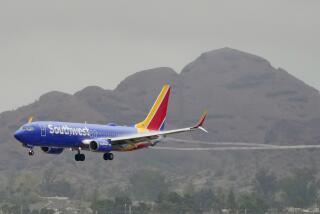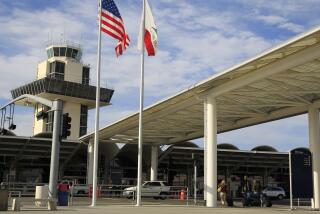Alaska Air--Small Start, Big Success
SEATTLE — The influential Alaska Business Monthly pondered recently whether Alaska Airlines had outgrown its name.
More than a half century ago, it flew just one three-passenger plane out of Anchorage. And for many years, even as it grew, it flew exclusively within Alaska. Today it serves more cities outside Alaska--16--than inside--14--and is not even based in Alaska anymore. More than half of its revenue comes from the “Lower 48.”
Nevertheless, the magazine said changing the airline’s name would not be a good idea. “Did the Los Angeles Rams change their name to the Anaheim Rams? Did the New York Jets and Giants become the New Jersey Jets and Giants?” the publication asked.
Management is also unlikely to entertain any suggestions that the name be changed--and it has already rejected proposals that the distinctive face of a smiling Eskimo on the tails of its 46 planes be removed.
“The name is so powerful. The name is real dynamite,” said Bruce R. Kennedy, the boyish 49-year-old chairman of the airline’s parent firm, Seattle-based Alaska Airlines Group. “We have to convince people that Alaska Airlines doesn’t just go only to Alaska anymore than AirCal flew only in California.
“But the name has emotional impact. When you say Alaska Airlines, people think of an igloo, they think of a whale, they think of a mountain, they think of fishing. We could name it West Coast Airlines but, like the names of many of the other airlines, that’s plain vanilla.”
Whatever it is called, Alaska Airlines is one of the nation’s most successful carriers, ranking 16th in terms of revenue passenger miles (the number of paying passengers multiplied by the number of miles flown). It has not suffered an annual loss since 1972. Even this year, with its profit dramatically pulled down by losses at its recently acquired Jet America subsidiary, Alaska Airlines expects to show a substantial profit.
And, though its management intends to fend off any takeover attempts, its success has made it a prime target. It is one of the industry’s few remaining attractive candidates for merger or takeover.
Jet America, which Alaska bought last year, has been Alaska’s biggest problem. The Long Beach-based carrier--which put most of its marketing emphasis on its nonstops between Long Beach and Chicago--was too small to compete effectively with major carriers, such as American, United and Delta. In the first six months of 1987, Jet America was $10 million in the red, resulting in a big drain on Alaska Air’s profit.
Eventually, Alaska’s management hopes, the Jet America purchase should improve Alaska Airlines’ West Coast niche. But for now, it continues to sap Alaska Airlines’ financial condition.
“The bad news is that termination of Jet America’s operations should add about $2 million to $3 million (a quarter) to expenses,” estimated Edmund S. Greenslet, airline analyst for Merrill Lynch, a New York brokerage house, because Alaska Airlines, with its higher operating costs, has taken over the remaining Jet America routes.
The Jet America purchase, with its mainly east-west route system, was supposed to reduce the seasonality of Alaska Airlines’ route system. But new competitors entered what had been monopoly markets for Jet America so, even with its low cost structure, it was unable to be profitable.
Faced with increasing competition in Jet America’s routes between Eastern cities and Long Beach, Alaska Air Group in September halted Jet America’s operations east of the Rockies, including routes to Minneapolis, Dallas, St. Louis, Chicago, Washington and Detroit.
Sold Landing Slots
Jet America was folded into Alaska Airlines on Oct. 1, and the Jet America name disappeared from scheduled flights. The combined operation has become the dominant carrier at Long Beach airport, but all of Jet America’s points outside California were closed.
Alaska sold Jet America’s four valuable landing slots in Washington and 14 at Chicago’s O’Hare Airport for between $10 million and $11 million, about a third of what it paid for the carrier. The Jet America planes were redeployed from their east-west routes to open new markets for Alaska Airlines and to increase the number of flights on the airline’s north-south route network on the Pacific Coast.
As a result, the airline is boosting its presence along the coast at a time when competitors shift their service elsewhere. A number of competitors have abandoned or pared back flight frequencies on the routes that Alaska Airlines is emphasizing.
Three airlines have announced reductions in Seattle-Anchorage flights and a few others have cut back schedules on Seattle-California routes. Alaska Airlines is taking this opportunity to introduce new jet service or increase the service it now offers. As a result, it is likely to pick up new passengers, benefiting load factors and yields and--it is hoped--significantly strengthening the bottom line.
Alaska Airlines has been able to compete more effectively because its former major rivals, Western, Pacific Southwest and AirCal, have been taken over by other carriers recently--Western by Delta, PSA by USAir and AirCal by American.
“The profitability of Alaska Airlines is beginning to benefit (because) the acquired carriers’ labor costs have been increased as a result of the acquisitions,” said Michael R. Armellino, airline analyst with the New York brokerage house of Goldman, Sachs. “And point-to-point service in local markets is to some extent being subordinated to needs of the acquiring airlines’ hubs, enhancing Alaska Airlines’ competitive pricing and service characteristics.”
As a result of its merger with Jet America, Alaska Airlines has dramatically increased intraCalifornia service, introducing service between San Jose and Burbank, Oakland and Burbank, and San Francisco and Burbank. It has also begun San Francisco-Portland and Los Angeles-Portland service, and reinstated Oakland-Long Beach service and a route between San Francisco and Ontario.
Originally, Alaska Airlines Group intended to retain the Jet America name, partially as a potential weapon against its own labor unions. “We wanted to keep it (Jet America) independent,” Kennedy said. “We also wanted to have a vehicle (to use) if our people stonewalled us on labor-cost concessions. It gave us a lever.”
Jet America was a non-union airline, though now its employees have all joined Alaska Airline unions. When the merger was announced in 1986, Alaska Airlines employees were worried. They thought that the company would use Jet America as a vehicle to oust their unions.
Despite Alaska Airlines’ denials, the employees feared that Jet America would become the surviving airline and that all of Alaska’s workers would become Jet America employees at substantially reduced wages. As a result, the Alaska’s pilots and other labor unions quickly ratified wage reductions that had been agreed to earlier but had been held up awaiting final approval by the workers.
The pilots, for example, agreed to a 8.63% wage reduction. That and productivity improvements by the pilots reduced costs by 20%--about $6 million--annually. Other unions followed suit.
Ending Jet America’s service east of the Rockies and merging the operations of the two carriers enabled Alaska Airlines “to make a rapid expansion into California markets--the Bay Area to Southern California,” Kennedy said. “We put six of the Jet America planes into the intraCalifornia market.”
The big question now is whether Alaska Airlines will continue in existence as an independent carrier.
“The shifting market focus of Alaska’s competitors and its improved relative cost position should provide Alaska Airlines with an opportunity to increase its West Coast profitability,” said Armellino of Goldman, Sachs. But “Alaska Airlines’ presence at Seattle, a logical springboard to the Far East, make (it) a potential strategic fit for a number of carriers,” said Michael A. Hamilton, managing director of Piper, Jaffray & Hopwood, a Minneapolis-based brokerage.
Although the airline “is an attractive acquisition candidate,” Hamilton continued, “its management has a strong preference to keep Alaska Airlines as a high-quality independent regional carrier.”
Whether the threat of a takeover becomes serious will hinge on three things, he said: “The ultimate strategic importance it holds to a major carrier,” the degree to which “the company can demonstrate attractive financial returns as an independent” and “the posture which the Department of Transportation will take toward further large-scale mergers in an increasingly consolidated environment.”
Kennedy is philosophical about the the company’s ability to fight off unwanted suitors. “We’re a nice little carrier on our own,” he said, “but we might not necessarily be an effective complement to other airlines.”
But, he acknowledged, Alaska Airlines exists “at the mercy of the big carriers.”
One of the major carriers, he said, could decide “to stamp out one of the few remaining small airlines. It could happen and it could happen very quickly.” And, he conceded, there would be little his airline could do.
“I am comfortable living with the uncertainly. I don’t think we can control it,” he said. “All we can do is watch for opportunities to grow, stay profitable and do the best we can.”
More to Read
Inside the business of entertainment
The Wide Shot brings you news, analysis and insights on everything from streaming wars to production — and what it all means for the future.
You may occasionally receive promotional content from the Los Angeles Times.









